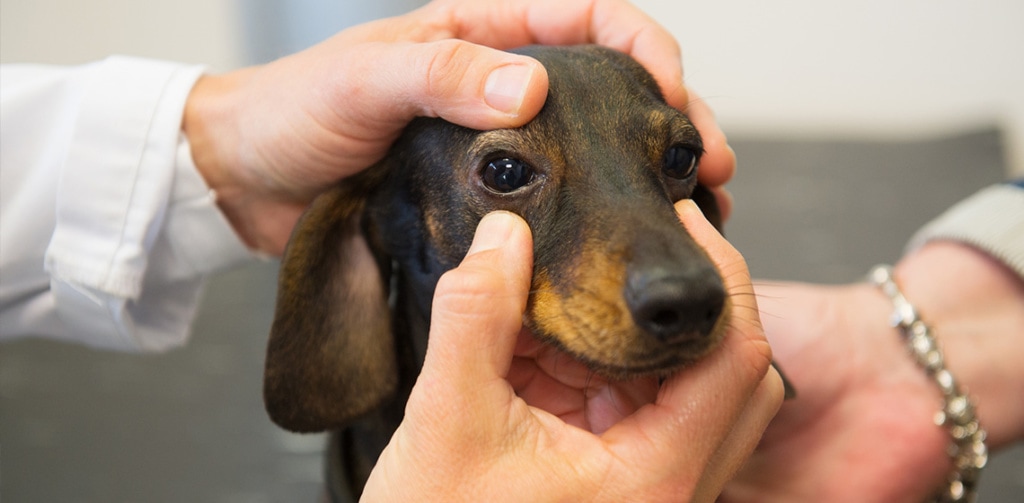Eye conditions are common in dogs, with allergies being a common cause, especially in summer. The symptoms of dog eye allergies are similar to many other eye conditions, so diagnosis and treatment by a veterinarian is needed.
Severity:
Mild to moderate
Table of Contents
Key points
Dog eye allergies cause red, watery, itchy eyes.
Diagnosis is by history, physical exam, eliminating other conditions and testing for allergies.
Treatment is with eye drops for simple cases, or by mouth in more generalized allergies.
Treatment may be life-long, especially if the allergen(s) cannot be completely avoided.
Common in
Young dogs under 3 years, but can develop at any age.
Any breed but some breeds are more prone; such as Retrievers, Boxers, German Shepherds, Poodles and West Highland White Terriers.
Symptoms & types
The medical term for dog eye allergies is ‘allergic conjunctivitis’. Conjunctivitis means inflammation of the conjunctiva, the transparent membrane covering the surface of the eye and the inner surface of the eyelids.
The symptoms of dog eye allergies are quite non-specific, meaning they could also be caused by several other conditions such as eye injury. Common symptoms include:
- Red, bloodshot eyes
- Weepy eyes
- Squinting or blinking more than usual
- Itchy eyes: pawing at the face or rubbing the face on the ground
- Sore skin surrounding the eyes
Dog eye allergies can be caused by allergies to food, pollen, dust mites, cigarette smoke, perfumes, or household cleaning products.
A green, gunky discharge is not a symptom of dog eye allergies. However, you may well see this type of discharge as a secondary consequence of the allergies. This usually indicates an infection. Dogs with allergic conjunctivitis are more prone to eye infections, as the inflammation of the conjunctiva weakens the eye’s defense against bacteria and viruses.
Dogs with allergic conjunctivitis often have other symptoms of allergies too, such as recurring skin complaints, itchy ears or ear infections, and possibly gut symptoms.
It’s really important that you take your dog to a veterinarian if they show any eye symptoms. This is especially important because the symptoms of dog eye allergies can also be caused by other medical conditions. Some eye conditions can become serious very quickly, so the sooner you have a diagnosis the better.
Understanding the diagnostics
Dog eye allergies are caused by the immune system overreacting to something in the dog’s environment. The immune system mistakenly sees the allergen (the thing your dog is allergic to) as a threat and mounts an inflammatory response against it. This means redness, swelling, heat, and itching.
Just like us, dogs can be allergic to almost anything. However, some allergies are more common than others. Dog eye allergies can be caused by allergies to food, pollen, dust mites, cigarette smoke, perfumes, or household cleaning products.
Learning about the causes
Your veterinarian will start by examining your dog’s eyes. This could also involve using drops called fluorescein to look for any damage to the conjunctiva, or taking a swab of the surface of the eye to look for signs of allergic inflammation. They may then examine your dog’s skin and ears too. Your veterinarian may suspect allergic conjunctivitis from their exam and your dog’s medical history.
Dog eye allergies are usually diagnosed by ruling out the other conditions that can cause these symptoms, such as foreign bodies, infections, or dry eye (keratoconjunctivitis sicca, KCS). If there is a secondary infection present, your veterinarian may wish to treat the infection and then see you back if the symptoms recur, making allergies more likely.
If your veterinarian gives you instructions for a diet trial, follow them to the letter! Don’t be tempted to think the odd treat won’t hurt, it will invalidate the diet trial and take longer to get to the bottom of your dog’s allergies.
Once your veterinarian has ruled out other causes and suspects eye allergies, they may suggest investigating what your dog is allergic to. There are three main ways of investigating allergies in dogs:
- A diet trial. This involves feeding your dog a special diet for 6-12 weeks. This will either be a diet with a new protein source, or a diet that has been ‘hydrolyzed’ (the protein broken down so the body cannot react to it). If the symptoms improve, food allergy would be suspected. You would then be asked to ‘re-challenge’ your dog with their old food. If the symptoms recur, a food allergy is diagnosed. Food trials should only be performed under the guidance and instruction of your veterinarian.
- A blood test. This looks for antibodies to common allergens, which are produced in allergies.
- Skin testing. Tiny amounts of common allergens are injected under the skin, under sedation, or general anesthetic, and the area is monitored for a reaction. This is considered more accurate than blood testing.
Once you know what your dog is allergic to, you can try to avoid the allergens as much as possible.
Best treatment options
There are several treatments available for dog eye allergies, all of which should only be used as directed by, and under the instruction of, your veterinarian. If used inappropriately, they can cause more harm than good.
- Antihistamines. Your veterinarian may prescribe antihistamines by mouth or in eye drops. These work by counteracting the allergic reaction itself. Antihistamine eye drops tend to be the most effective.
- Anti-inflammatories. Again, your veterinarian could prescribe these by mouth or topically in eye drops. These help to reduce the inflammation of the conjunctiva and so reduce the symptoms.
- Steroids. These are usually prescribed as steroid eye drops unless your dog has itchy skin, in which case they may be prescribed in tablet form. Steroid eye drops are usually only used in severe eye allergy flare-ups, for a short period of time. This is because there are risks to long-term use, such as an increased risk of glaucoma.
If your dog also has more generalized allergy symptoms such as itchy skin, your veterinarian may discuss other ongoing allergy medications by mouth, topical medications for the skin, or immunotherapy.
Home remedies and their effectiveness
Unfortunately, home remedies don’t tend to be effective. They may temporarily improve symptoms but wouldn’t provide an effective long-term solution. It’s best to leave the treatment to your veterinarian.
However, there are plenty of things you can do at home to try to help reduce the number, or severity, of symptom flare-ups. Depending on your dog’s specific allergies these include:
- Eliminate your dog’s contact with their allergen(s) as much as possible.
- Use saline eyewash to bathe your dog’s eyes and the surrounding fur after walks. This helps by washing some of the pollen away. N.B. never use contact lens solution for this, speak with your veterinarian about saline eyewash for dogs.
- Use false tears to keep the eyes lubricated. Again, speak with your veterinarian about the best false tears to use for your dog.
- Perform enhanced cleaning of your home. Hoovering regularly can help, as can washing your dog’s bedding on a hot wash. Where possible, wash soft furnishings regularly.
- If your veterinarian gives you instructions for a diet trial, follow them to the letter! Don’t be tempted to think the odd treat won’t hurt, it will invalidate the diet trial and take longer to get to the bottom of your dog’s allergies.
- Use a plastic cone, or buster collar, to prevent your dog from itching their eyes and making the condition worse.
Home remedies may temporarily improve symptoms but wouldn’t provide an effective long-term solution. It’s best to leave the treatment to your veterinarian.
When to see a vet
It’s important that you see a veterinarian sooner rather than later if your dog has any symptoms relating to their eyes, as you need to be sure what the problem is before starting any treatments. Some eye conditions can become very serious very quickly, so it’s best not to hang around. Eye conditions can also be very painful!
Final thoughts
Dog eye allergies are fairly common. Allergic conjunctivitis is sore and itchy, much like hay fever for us. Not to mention it can lead to secondary infections if left untreated. Signs of dog eye allergies may be accompanied by other symptoms suggestive of allergies, such as skin problems or digestive issues. If you suspect your dog may be suffering from dog eye allergies, see your veterinarian for a diagnosis as soon as possible.
FAQ
You may suspect eye allergies if your dog has red, watery, itchy eyes. However, other conditions can also cause these symptoms, so you’ll only know for sure by taking your dog to a veterinarian.
You can help by using warm water to keep the area around your dog’s eyes clean and using false tears for dogs, but the treatment itself needs to be prescribed by a veterinarian.
There are various eye drops available, containing antihistamines, anti-inflammatories, or steroids. Your veterinarian will prescribe the best treatment for your dog’s individual needs.
False tears can help, by keeping the eye lubricated and helping to wash out any allergens. Saline eyewash can be soothing too.
Only in some circumstances and only if instructed to do so by your veterinarian. Some human eye drops could be very harmful.

Sarah-Jane Molier wanted to be a veterinarian from around the age of ten. After much hard work, and her first degree in animal science, she realized this dream and graduated in 2009. She has been working in small animal clinics ever since.








